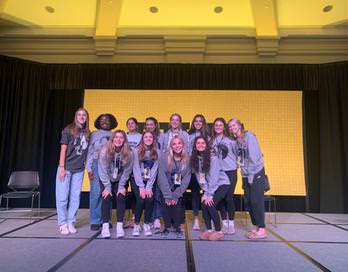
Introduction
Women now account for 50.7% of the college-educated labor force, having surpassed men as of 2023. According to a McKinsey & Company study, companies with female leaders demonstrate higher success rates in organization and financial performance. Regarding college acceptances throughout the country, women have been proven to have higher acceptance rates compared to their male counterparts.
Women are statistically outperforming men in various categories, but this has not always been the case. For centuries, boys seemingly held the upper hand in various facets of life like academics and careers.
However, a shift is underway, with girls increasingly outperforming boys in education and the workforce. The male-female gap in aptitude is narrowing, with girls and women finding themselves at the top of the scoreboard after years of competition.
In contrast, men are seemingly falling behind women. Between lower college acceptance and graduation rates and higher dropout rates, women are demonstrating that they are more than equal to men in academics. In fact, this gender gap has become alarming to some, including the Commons Select Committee, who said in a recent report, “We are increasingly concerned about male participation.”
But why is this the case?
Female Perspective
Women’s profound success in the workforce can be largely attributed to changing social norms. Women are more widely accepted into the workforce now as compared to just 60 years ago, a time when women were ridiculed for wanting a career.
“The ’60s were hard on women,” stated former corporate employee Gwendolyn Williams on an internet forum about womens rights in the 1960s.. “A highly educated woman made peanut change compared to men. We could usually not purchase a home unless we were married. I think many employers assumed we would get a job, find a husband, and the corporate knowledge would evaporate.”
Since that fateful decade in women’s rights, corporate America has opened its doors to women through legislation protecting women’s place in the workforce. The Equal Pay Act of 1963 gave women the security of equal wages as compared to their male coworkers. Title VII, the Pregnancy Discrimination Act and the Fair Labor Standards Act all aim to protect women in the workforce against discrimination and iniquity.
Women have flourished since obtaining equal protection laws, finding more success in careers than ever before. While women are still underrepresented in executive positions in many industries, there is still a gradual increase in female leadership positions.
Female initiative programs have also been beneficial for women by helping them succeed in the workforce and in spaces previously dominated by men. Organizations like Girls Who Code and Women in Stem both aim to empower young women to follow their passions in STEM-oriented fields, and as a result, STEM majors are seeing higher rates of female students than ever before. Industries previously dominated by men are seeing an influx of successful females, further closing the gender gap in technology and science fields.
But the reasoning for women’s success in the 21st century runs deeper than laws and organizations that support women.
Women have been battered down throughout history, being held from having careers and finding success in education. But in the 21st century, they are rising up against a history of being undermined, disrespected, and limited. In an age where feminism and female leadership is not only socially acceptable but promoted, women are proving their capabilities in every field from STEM to entrepreneurship and finance.
Julie Anderson, a wealth manager at Overberg Asset Management, examined women’s success in finance compared to men. “Despite being less risk-tolerant, women are responsive to facts and make considered decisions,” she explained. “In contrast, men tend to be overconfident regarding investments and tend to overtrade. Additionally, contrary to prevailing beliefs, women are far less emotional than men in making investment decisions.”
Male Perspective
As the 21st century progresses, women have found themselves scaling the corporate ladder at an unprecedented speed. But women’s formidability is not alone to blame for the expanding gender gap in education and the workforce.
Men have found themselves to be struggling to catch up with women, in education particularly.
A new study by the Higher Education Policy Institute found that not only do women outnumber men at almost every university across the U.S., but they are more likely to get a good degree and less likely to drop out.
Across cultures and ethnicities, including those influenced by religious norms that may downplay the importance of female education, women and still outnumbering men at universities all over the world.
These patterns demonstrate that men simply lack drive compared to women in the 21st century, but this has not always been the case. So what has changed?
Part of the reason why boys and men are falling behind women in education particularly is that they are developmentally behind girls. Cal State Fullerton professor Loakim Boutakidis has a specialty in child and adolescent studies, and examined how developmental psychology impacts boys’ performance in educational settings compared to girls.
“Studies have shown that boys may be a bit behind girls developmentally when they begin formal classroom instruction. When it comes to the parts of the brain that are about executive functioning, delayed gratification and self regulation, those mature later for boys than they do for girls,” said Boutakidis. “Once boys are on this trajectory, it tends to generate these self-sustaining effects, and the gap continues to widen as they go through high school and college.”
Polls have also indicated that boys simply do not often have the capacity to engage with typical learning environments compared to girls. Due to limited attention spans and delayed maturity compared to girls, boys often find themselves struggling to meet proficiency standards and engage in the classroom. “In middle school, once classes became more difficult, I felt like it was harder to focus,” stated sophomore Karthik Ganesh. “It is difficult to be engaged in a class that I have no interest in, and I find myself getting distracted and talking when I am supposed to be paying attention.”
But it is not just a biological battle between male and female learning aptitudes that are the reason for the gender gap in education. Men and women have followed drastically different paths to get where they are today.
While women have spent decades fighting for a seat at the executive level, men have historically been placed into leadership positions almost as a right of birth. Women have been forced to overachieve in order to prove themselves, while men have grown quite comfortable in a patriarchal society.
As a result, women are generally putting in more effort than men to find success and abolish stereotypes. This, coupled with superior learning capabilities, has resulted in a female domination in education. Men have competition for the first time, and after a history of being accustomed to automatic respect, it is a difficult pill to swallow that they must now fight for their positions as leaders.
No matter which side the gender disparity gap favors, it is an ongoing issue that men and women simply cannot find balance. It is shown historically that one gender always seems to be taking away from the other, and that women and men have been pitted against one another in the race to success. Shelley Zalis, a champion of gender equality, emphasized the importance of gender equality going both ways. “When we make the invisible visible, it becomes clear that gender parity isn’t just a “women’s issue.” It’s a human one.”


















Tessa Ross • May 20, 2024 at 12:12 pm
This has really propelled society forward. Women’s skills are very much in need today. Men must take on support roles in the 21st century. We as women are simply more qualified and have outworked men. Even better is that men realize this and give us higher marks as leaders! What a wonderful time to be a woman!
David AuCoin • Apr 18, 2024 at 7:15 pm
The biggest reason why boys are at a disadvantage in modern society is the huge maturity advantage women have. Its been underrated in the above blog. Girls have reached full adult maturity at just 12 years of age while boys don’t
even begin their transformation from defective girls into fully adult males until their 13 and doesn’t end until the early twenties.
We can not expect boys to be able to keep up with girls who are 6 to 10 years more mature than they are. In addition fathers are not sticking up for their sons as much as they are for their daughters. Its seems that everything girls want males are eager to give them. Girls can play on boy teams even when they have a team of their own and they can play on both the boy team and the girl team in the same season if scheduling will allow it and it has been male judges who have approve it and, male coaches who are eager to get together with the coaches of girl teams to modify the scheduling of contest times so girls can play on both teams. in the same season. Men are far to accommodating to give girls every conceivable advantage over boys.
I don’t know how we can solve the huge maturity advantage girls have because of their much earlier maturity. But at the present time there doesn’t seem to be a desire to help our disadvantage boys. Its only when girls are disadvantaged
does there seem to be any interest in solving a probe girls have .
It seems like that old mother goose nursery rhyme is coming true.
What are little boys made of? Snails and puppy dog tails. And what are little girls made of Sugar and spices and all things nicest.
Megan Merrell • Apr 16, 2024 at 9:12 am
I love how much woman are starting to be finally more successful than men even thought it is highly still more difficult for them